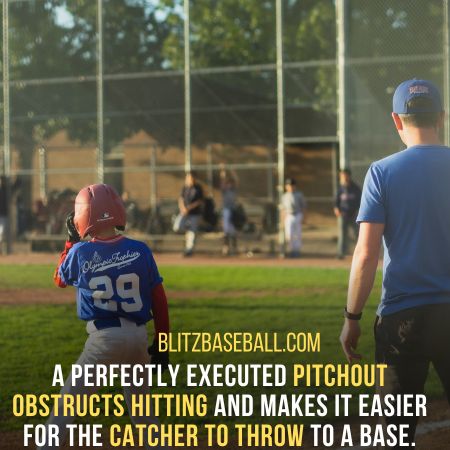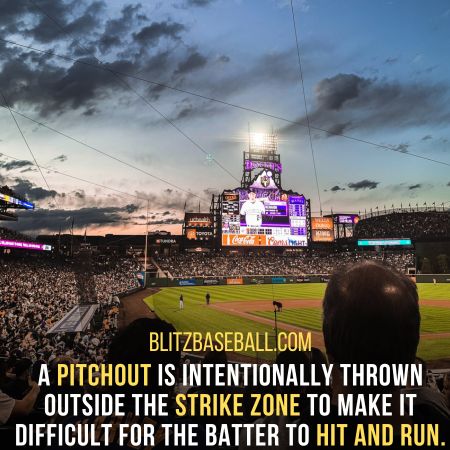Do you know what is a pitching out in baseball? In the realm of baseball, the pitchout serves as a strategic maneuver employed by pitchers to intentionally throw a ball outside the strike zone.
Its primary objective is to impede the batter’s ability to execute a hit and run, while also creating an opportunity for the catcher to make a play.
A well-executed pitchout not only hinders the batter’s chances of making contact with the ball, but also allows the catcher to receive the ball in a standing position, enabling a more forceful throw. By directing the ball away from the batter, the catcher gains ample space to execute a precise throw.
Typically, the catcher catches the ball before it reaches the first base player, while the pitcher throws the ball at an angle that facilitates the catcher’s subsequent throw to second base.
Additionally, it is important to note that there are various other types of outs in baseball, including fly outs, foul outs, tag outs, force outs, strikeouts, ground outs, and line outs. Understanding the intricacies of different pitches and outs in baseball enhances the overall appreciation of the game.
Key Takeaways
- A pitchout is intentionally thrown outside the strike zone to make it difficult for the batter to hit and run.
- A perfectly executed pitchout obstructs hitting and makes it easier for the catcher to throw to a base.
- The catcher can catch the ball in a standing position and throw with more force due to the ball being far away from the batter.
- Types of outs in baseball include fly out, foul out, tag out, force out, strikeout, ground out, and line out.
What Is A Pitching Out In Baseball
A pitchout in baseball refers to the intentional act of throwing a ball outside the strike zone, making it difficult for the batter to hit and run, while also providing the catcher with an advantageous position to throw the ball to a base.
This strategic move has several benefits. Firstly, a perfectly executed pitchout obstructs hitting, as the ball is far away from the batter, giving the catcher ample space to catch the ball in a standing position and throw with more force.
Secondly, it makes it easier for the catcher to throw to a base, particularly when trying to catch a player stealing. By throwing the ball at an angle, the pitcher allows the catcher to catch the ball before it reaches the player on first base and quickly throws to the intended base.
A pitchout is a valuable tool in a team’s defensive strategy, effectively hindering the batter and increasing the chances of an out.

Types of outs
There are several different types of outs that can occur in the game of baseball. These outs play a crucial role in determining the outcome of the game. Here is a table that outlines some common types of outs in baseball:
| Type of Out | Description |
|---|---|
| Fly out | Batter hits the ball in the air and the catcher catches it |
| Foul out | Hitter hits the ball in foul territory and the fielder catches it |
| Tag out | Fielder tags the batter with the ball or touches them with the glove holding the ball |
| Force out | Infielder catches the ball and throws it to first base before the runner reaches |
Executing a successful pitchout in baseball requires strategic planning and coordination between the pitcher and the catcher. The aim is to throw the ball intentionally outside the strike zone to make it difficult for the batter to hit and run.
However, there are common mistakes that should be avoided when attempting a pitchout, such as throwing the ball too close to the strike zone or failing to communicate effectively with the catcher.
By understanding these strategies and avoiding common mistakes, teams can increase their chances of executing a successful pitchout and securing an out.
Types of pitches
One common type of pitch in the game of baseball is the fastball, which is frequently used to confuse the batter and is considered the most challenging pitch to hit.

Pitchers employ various techniques to effectively throw different types of pitches. For example, the four-seam fastball is known for its high velocity and straight trajectory, making it difficult for batters to make solid contact.
Other variations of the fastball, such as the cutter, sinker, split-finger fastball, and two-seam fastball, offer different degrees of movement and deception.
Strategies for effectively using these pitches involve changing the batter’s eye level, altering speeds, and locating the pitch in different strike zone areas.
By mastering these pitching techniques and understanding how to strategically use each pitch, pitchers can keep batters off balance and increase their chances of success in the game.
Frequently Asked Questions
How does a pitchout affect the count and the base runners?
A pitchout in baseball affects the count and the base runners by giving the defense an advantage. It forces the batter to be more cautious, potentially leading to a higher ball count. It also makes it difficult for base runners to steal or advance.
What are some common strategies for using a pitchout in a game?
Common pitchout strategies in baseball include using it to prevent stolen bases, catch runners off guard, or induce a double play. To effectively execute a pitchout, the pitcher must aim outside the strike zone, while the catcher positions themselves to quickly throw to a base.
Are there any risks or drawbacks to using a pitchout?
There are some risks and drawbacks to using a pitchout in baseball. One risk is that the catcher may not be able to catch the pitch, resulting in a potential stolen base. Additionally, if the pitchout is not executed properly, it can give the batter an advantage by allowing them to anticipate the pitch and adjust their swing accordingly.
How does the catcher communicate with the pitcher to execute a pitchout?
Catcher pitcher communication is crucial for executing a pitchout in baseball. The catcher typically signals the pitcher using hand gestures or signs to indicate the pitchout. This allows the pitcher to adjust their throw to intentionally throw outside the strike zone.
Can a pitchout be called by the catcher without the pitcher’s knowledge or consent?
The catcher plays a crucial role in pitch sequencing, including calling for a pitchout. A pitchout can deter stolen base attempts by obstructing the batter and allowing the catcher to make a strong throw to a base.

Conclusion
A pitchout in baseball is an intentional throw by the pitcher outside the strike zone. It is used to prevent the batter from successfully executing a hit and run play and to facilitate a potential play by the catcher.
The catcher catches the ball in a standing position, allowing for a more forceful throw. A well-executed pitchout provides ample space for the catcher to catch and throw the ball to second base.
Understanding the different types of pitches and outs in baseball enhances the overall enjoyment of the game.
